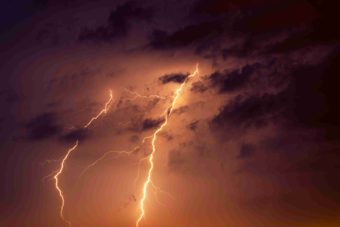NGSS Ideas
Three ways to Talk about Electricity in Nature

Most kids don’t spend time worrying about how we get electricity. As long as they can charge their cell phones, keep their televisions running, and microwave a hot pocket when they get hungry, they happily ignore it. They study electricity in school and do some of the standard experiments like connecting snap-together circuits and seeing how much lemon juice it takes to power a light bulb. But why not switch it up a little by looking at how electricity occurs in nature? After all, that’s what got humans interested in it in the first place!
The first records we have of humans being curious about electricity are in the notes of the Greek philosopher Thales of Miletus. He wrote about the static charge he could create by rubbing fur on amber. Static electricity is a good jumping off point, and the easiest place to look at it is in the sky during a thunderstorm, in the form of lightning.
Lightning

Lightning occurs when static electricity releases from clouds. A negative charge builds up in clouds as the clouds increase in size and get high enough in the sky for ice to form. The ice particles bump into each other causing an electrical charge to build. The negatively charged particles sink toward the bottom of the cloud and the positively charged particles rise. When the negatively charged particles are attracted strongly enough to something with a positive charge, they collide causing the static energy to release in the form of a huge spark. For some resources on lightning, look at this page.
Electroreception

Some species are considered weakly electric because they can sense and emit electrical signals. They use the signals to communicate, find mates, and to hunt prey. They also use it as a locating system. Being able to sense the signal is called electroreception. Sharks use electroreception to hunt. They have tiny pores that are filled with cells called ampullae. These cells contain an electric jelly senses electric signals.
Most weakly electric species are aquatic, but we know of a few exceptions. Bees generate static electricity that they use to detect weakly electric signals sent out by flowers. Platypus and echidna are both weakly electric. For more on electroreception,see this page.
Auroras

Auroras are light displays that occur in the northern (Aurora Borealis) and southern (Aurora Australis) hemispheres. They occur when electrically charged particles from the sun reach the earth’s atmosphere. The charged particles collide with gases in our atmosphere and excite the electrons, causing them to move to a higher energy state. When the energy state drops back down, they release photons, or particles of light. The color of the light depends on the type and elevation of the gas that reacted to the electron. For more on auroras, see this page.
